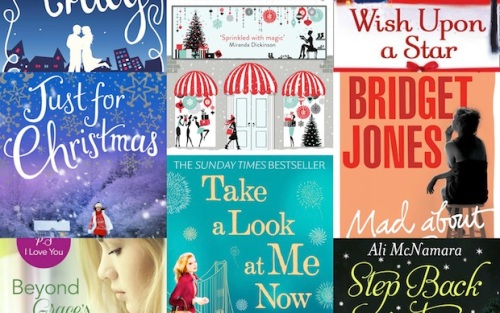Last week, my book cover was wrongly featured in a blog post on The Spectator website, along with covers of authors I know and love. The article wasn’t even about our supposed genre, so I can only assume our covers were used as ‘click-bait’. We were accused, by implication, of writing ‘crap books’. So, I feel I have a right to reply…
The header image used in The Spectator blog article, Let me introduce you to ‘sick chick lit’ has now been changed to a stock image. But this is the image originally posted (thank goodness for Google’s image caching):
(Books featured above: Take a Look at Me Now by Miranda Dickinson; Yours Truly by Kirsty Greenwood; Christmas at Carrington’s by Alexandra Brown; Wish Upon a Star by Trisha Ashley; Just for Christmas by Scarlett Bailey; Beyond Grace’s Rainbow by Carmel Harrington; Bridget Jones – Mad About the Boy by Helen Fielding; and Step Back in Time by Ali McNamara.)
The article was supposed to be about the author’s dislike for Gone Girl and Before I Go to Sleep, which, she appeared to be arguing, represented a cynical plot by publishers to extend the chick-lit genre (whatever that actually means) to books with a domestic violence storyline. So why our book covers were used is a mystery. But the inference in the article was that women’s fiction books (into which many varied female authors are lumped together as ‘chick-lit’ by lazy journalists) were crap: “Chick lit has its place,” the author stated. “I’m not being snobby about crap books.”
I don’t write crap books, thank you very much.
Neither do any of the authors featured in the original header image to that article. Had the author of the piece actually bothered to read any of the books, she would have found stories of women empowering themselves, bucking the status quo, refusing to put up with crap jobs and unreliable partners, overcoming fears and growing as individuals. Yes, there might be romantic threads in the books. Yes, the protagonists may be female. But the stories are inspiring, entertaining, thought-provoking and relevant to the lives of thousands of readers. And that seems to be the main crux of the article writer’s problem.
“The basic chick-lit plot centres on getting a man, keeping a man or coping with a man when he leaves you/is being a total bell end,” the article states. Well, in that case, Take a Look at Me Now is not a basic chick-lit plot. It’s about a woman who, when life deals her a blow, refuses to lie down and take it and instead takes control back by doing something just for her. In the course of that experience she reconnects with an ambition to start her own business, which empowers her to make it happen. Yes, there is a romantic sub-plot, but whether she ‘gets a man’ or not is an added extra, rather than the main event (and, crucially, is her choice, adding to the empowerment theme).
What I strongly object to is the idea that only self-appointed literary ‘experts’ can dictate what readers should be reading. That reading should be a joyless slog; and that, by definition, any enjoyment one finds within the pages of a book is instantly unworthy. Great stories are those which meet us where we are and take us somewhere else – they challenge, amuse, terrify along the way but, most importantly, entertain us. And great stories do not fit in genres defined by the media or publishers. Real readers know this already – and the reason books like those featured above are popular is that readers connect with the stories within and recommend to other people. Readers are savvy, intelligent individuals who will seek out great stories, without having to rely on self-important ‘experts’ to help them.
I would hazard a guess that Take a Look at Me Now was used in the header because there is a woman with a handbag on the cover. Let me let you into a little secret here: I hate that handbag! I argued against it, not least because my protagonist Nell never goes shopping in the book, but also because the woman is too thin and at no point in any of my novels do I prescribe body shape (or have my protagonists obsessing about ‘big bums’). The point is, authors rarely have a say in book cover designs, a bi-product of which is that it unfortunately allows literary snobs to make idiotic snap judgements about our books without reading them.
As I said in my comment on The Spectator article, it would seem that the old adage, ‘Don’t judge a book by its cover’ is as pertinent today as it ever was. So, dear ‘literary commentators’, please let readers decide what is worthy of their time – and stop decrying the sheer pleasure of reading!


 https://www.etsy.com/uk/shop
https://www.etsy.com/uk/shop